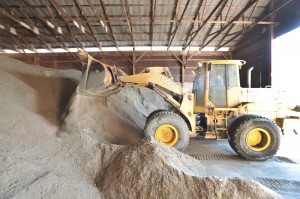WESTFIELD – The City Council voted at its last meeting to allow the Department of Public Works to deficit spend in its snow and ice treatment accounts to make travel on city roads as safe as possible.
And, if this winter is close in severity to recent winter seasons, the city will spend more than a million dollars, with nearly $800,000 of that in the red ink of deficit spending.
Snow and ice removal is one of the few areas of municipal budgets where deficit spending is allowed, with several options to pay the deficit allowed. Westfield typically transfers money at the end of the fiscal year to retire that deficit.
Massachusetts General Law, Chapter 44 states:
Section 31D. Any city or town may incur liability and make expenditures in any fiscal year in excess of available appropriations for snow and ice removal, provided that such expenditures are approved by the town manager and the finance or advisory committee in a town having a town manager, by the selectmen and the finance or advisory committee in any other town, by the city manager and the city council in a city having a city manager or by the mayor and city council in any other city; provided, however, that the appropriation for such purposes in said fiscal year equaled or exceeded the appropriation for said purposes in the prior fiscal year. Expenditures made under authority of this section shall be certified to the board of assessors and included in the next annual tax rate.
The City Council has approved annual snow and ice budgets of about $400,365 for the past several years, far short of the cost of snow removal and ice treatment. The total cost for the 2013 fiscal year was $1,010,123, and for the 2014 fiscal year it was $1,224,532.
Interim Department of Public Works Superintendent Dave Billips said the problem of budgeting for winter road treatments is difficult because nobody can project the number, types and severity of winter storms.
Billips provided a breakdown of the costs associated with snow and ice removal, with the two largest expenditures in the area of supply, sand and salt, and in the area of contracted plows.
Billips said there are two types of events, both of which add to the deficit, plowable snow storms and ice storms. Each of those events are labor intensive, but the ice storms have the added cost of tons of sand and salt being applies to road surfaces.

A Southwick Department of Public Works employee mixes a salt/sand mixture at the former DPW yard. (File photo by Frederick Gore)
Billips said while in recent years winter road treatments have cost a million dollars or more, it makes sense to deficit spend.
“Why tie up that money when you know how variable New England winters can be,” Billips said, adding that demand for salt and sand are often reflected in higher process. The city paid $80 per ton of salt in 2009 and 2010, but that prices dropped into the range of $54 a ton during that last four years.
Billips said the cost of salt has jumped back to nearly the $80 per ton level this year.
“It went from the $55 range to $78, so it did increase because of the high demand last year,” Billips said. “The National Weather Service is predicting a wetter winter than normal this year, the long-range forecast is for an El Nino winter with above average snowfall.”
Southwick Department of Public Works Director Randy Brown said Southwick is paying $78.46 per ton for salt from Cargill this year, a big jump from last year.
“Last year we paid $54.68,” Brown said. “There is a global shortage of salt and we were very lucky to get by with the supply we had.”
Brown said everyone is seeing the effects of the shortage in their wallets. Southwick’s supply is limited to what the storage shed can hold at any one time but Brown said Southwick uses approximately 2,000 tons of salt throughout the winter.
In the hilltowns, predicting the amount of road sand and salt that will be used by highway departments is often an exercise in futility.
“We put $37,000 into an account for sand and salt each year,” said Charles Dazelle, highway superintendent for the town of Huntington. “Depending on the winter, it’s depends what we use.”
Dazelle, who has been with the department for 18 years, stated that the town is on a state blanket bid this winter and that the cost has risen exponentially.
“Last year I was paying $52 a ton (for salt). This year, I’m paying almost $74,” he said, adding that such a jump is not uncommon. “In 2008, when the price of fuel went up, salt kind of went high.”
“It’s tough for these towns. Back in April when we did it, we didn’t plan for a salt shortage,” Dazelle said. “I use anywhere from 250 to 300 tons of salt a year.”
The town of Huntington has about 38 miles of road, 26 of which are paved, with an additional 12 miles of dirt roads which Dazelle and his crew manage.
In Dazelle’s almost two decades, he said the most the department has spent on salt and sand is $55,000.
“We go back to the annual Special Town Meeting and vote to put more money in,” said Dazelle about town protocol in case of a salt shortage. “We always come under what it costs a year. The most we’ve ever gone over is $5,000. $35,000 is never enough and $40,000 is often too much, so we go $37,000.”
Hope E. Tremblay and Peter Francis contributed to this report.



